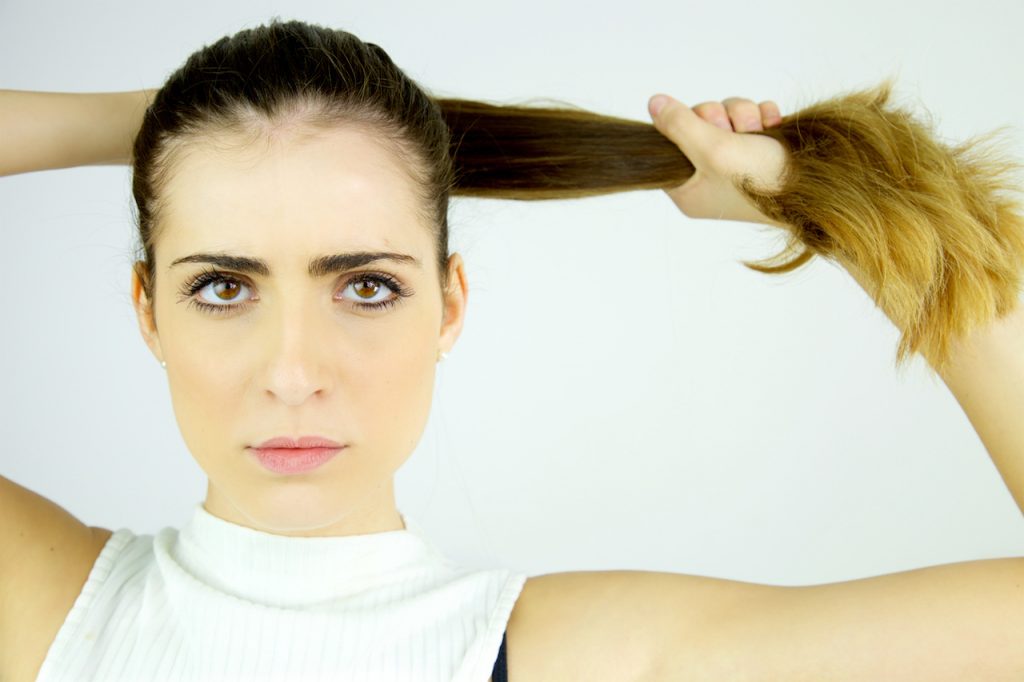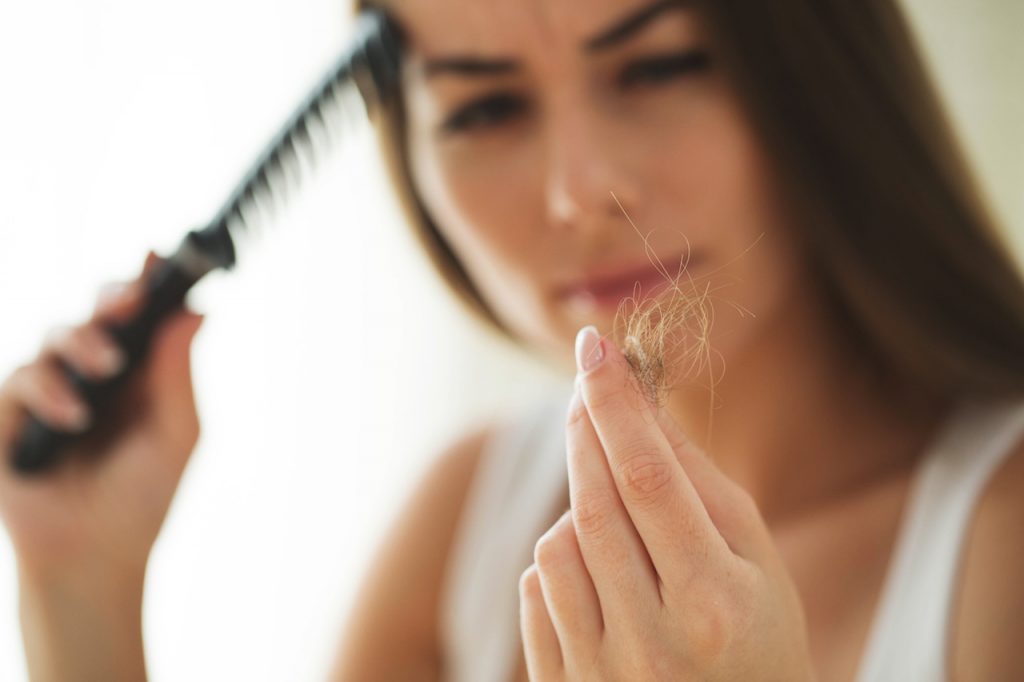Traction alopecia is a prevalent form of hair loss, particularly among African-American women. It involves hair loss where tight ponytails, braids, and other harsh grooming habits pull at the hair follicles. The temple and edges of the hairline are common areas localization. Often, when the beginning stages of traction begin to present themselves, the first step towards healing is preventing further trauma. However, the resources currently available on the best way to go about this usually include misinformation that promotes the use of some oil, without any research to back it up. This article is intended to provide general information accessible to the public, with detailed descriptions of traction alopecia, what causes it, when to consult a dermatologist, and the treatment methods available.
What Causes Traction Alopecia?
Traction alopecia, also called tension hair loss, is caused by hair follicles tensioned with the scalp; in other words, pulling the hair forcefully. This styling habit damages the structure of the hair follicles. Over time the hair follicles in question can be ripped out by the roots.
Many people associate traction alopecia with hairstyles, such as tight ponytails and braids.

Tight Ponytails
Pulling hair into a tight ponytail involves collecting the hair that frames the sides of the face and pulling towards the apex of the crown. Celebrities such as Arianna Grande and Bella Hadid are infamous for this exacting hairstyle. Since the hair around the edges of the face, i.e., the hairline and temple points, experience a greater pulling force than other areas, people tend to notice hair loss here first.
Braids
Similar to the conditions that result in hair loss from tight ponytails, braid hair loss can also be seen around the edges of the hairline. However, the design of various braiding styles opens up the possibility of additional points of hair loss. For example, styling hair into a Bantu-knot involves sectioning off hair, pulling it taught, and “screwing” into a rope-like shape. This rope is then twisted further, coiling the rope of hair in on itself. Thus, traction alopecia resulting from braids like these can potentially be dispersed.
After looking up their hair loss online, many women wondering “What is traction alopecia?” A standard follow-up is if it can be caused by wearing braids.
Relaxers and Hot Combs
A related form of hair loss often seen in association with harsh hairstyles is Central Centrifugal Cicatricial (CCCA). This is a condition in which harsh chemicals from relaxers and excessive heat from hot combs destroy hair follicles. This hair loss typically affects the crown of the head. Additional hair loss progresses gradually in a central or centrifugal pattern. Due to the popularity of relaxers in African-American hair salons, many women of African descent experience CCCA hair loss.
Wigs and Extensions
Some may opt to cover hair loss from traction alopecia. The go-to methods, however, may do more harm than good. Extensions, particularly heavy ones, can weigh down the hair and pull hair follicles by the roots. Wigs and weaves can have the same effect, particularly those that must be sewn in. When aiming to conceal hair loss with wigs and extensions, try to find lightweight options. Ideally, these should clip-in or use pins for securing.
When Does Hair Loss from Tight Hairstyles Start?
Due to the mechanical nature of hair loss from traction alopecia, there is not necessarily a definitive age for onset. Nickelodeon child star JoJo Siwa, previously on Dance Moms, has been the subject of much speculation about hair loss due to her signature high, tight ponytail. The star herself seems to be good-natured about the attention to her hairline. In a Q&A video on her YouTube channel, a fan asked, “where is your hairline going?” to which she laughed and answered, “In the trash!” While this attitude helps brush off negative attention, it is recommended that you address traction alopecia before it is too late to treat with non-surgical methods.

Steps for Traction Alopecia Prevention
In general, hair loss, mainly that which predominantly affects women, is an uncomfortable topic. This is why we at Dr.UGro™ compiled a list of steps you can follow to get started on prevention and opening a dialogue on a delicate issue.
- Awareness – Chances are, if you think you are losing hair around your edges, you’ve already done an internet search. You might have followed up by searching “what is traction alopecia?” after seeing it come up in several results. If that search leads you here, then you are on your way to becoming more aware of this common yet rarely discussed form of hair loss.
- Recognition – After becoming aware of what traction alopecia is and its causes, the next step is recognizing patterns in your grooming habits that could lead to this type of damage to your hair follicles.
- Making a Change – Now that you have identified possible harsh grooming habits in your routine, it’s time to make a change. You don’t have to stop styling your hair in ponytails or wearing braids altogether. Instead, try using less force to achieve your desired look.
- Monitor Your Edges – Continue to monitor your hairline for signs of traction alopecia. If you notice continued hair loss or your edges don’t seem to be growing back on their own, it may be time to consult a dermatologist near you.
How to Treat Traction Alopecia Naturally
If stopping harsh grooming habits does not reverse hair loss around the edges and temples, then a dermatologist may recommend using a topical medication such as Minoxidil. Rogaine, the most common form of Minoxidil, can be found over the counter in most pharmacies and drug stores. It works by increasing blood flow to the scalp to allow more oxygen and nutrients to replenish hair follicles. However, Minoxidil is only indicated for use on the crown. There is no guarantee of its effect on the hairline and edges.
Those interested in natural alternatives for what causes traction alopecia may want to look into other topical hair products. It is vital to pay attention to extraction methods to determine the carefully formulated from the cheap pretenders. A current trend is to push castor oil as an all-in-one fix-it serum. However, many similar products use heat to extract the oil from castor seeds, which de-natures the natural source’s chemical components associated with hair benefits. On the other hand, the cold formulation is a more involved process that preserves these delicate chemical components. Therefore, applying a carefully formulated natural botanical hair product allows for a more direct route to the hair follicles and scalp.
In more severe cases where scarring has occurred, a dermatologist may recommend a hair transplant procedure to restore hair loss.
Natural Hair Growth Product Tested As Effective
Dr. UGro Gashee is an all-natural product line that Dr. Sanusi Umar (a board-certified dermatologist and world-renowned hair transplant specialist) formulated to boost hair growth and health. The product line includes a hair lotion, pomade, and oral supplement — which are all effective for stimulating hair to grow thicker and more robust. They are ideal for individuals experiencing balding or even for those seeking to prevent hair thinning.
Over 95% of the ingredients in Gashee products are natural and plant-based. These products minimize potential hair damages by undergoing a cold-formulation process while encouraging maximum absorption.
A 2021 study examined the effects of Gashee products on patients experiencing extreme hair loss. The study presented the role of all-natural ingredients in combatting the balding patterns. According to the research, the plant-based ingredients helped all patients have drastic hair growth improvements.
VIDEO: Happy Gashee User Shares Hair Growth Results
Frequently Asked Questions – Traction Alopecia
Is there any particular hairstyle that causes traction alopecia?
In general, any hairstyle that pulls hair harshly can potentially cause traction alopecia. This includes ponytails, braids, buns (even man buns are not exempt), and the use of extensions and weaves. Hairstyles that require excessive heat or chemical relaxers can result in scarring alopecia, known as CCCA.
What are the steps for traction alopecia prevention?
After arming yourself with knowledge from reputable sources about traction alopecia and what causes it, you should be able to identify which of your grooming habits could be a potential cause. Using this information, adjust your grooming habits to be easier on your edges and roots and prevent further damage. Keep an eye on your boundaries and talks to your doctor if your hair loss continues or your hairline does not recover.
What are some natural and holistic traction alopecia remedies I can try at home?
There is no guarantee DIY traction alopecia remedies work. It would be best if you began by easing up on the pulling force in your braids, weaves, or ponytails. Often, many online self-help guides suggest the use of various oils. Many are not based on science, but research works support selecting multiple plant extracts and oils in naturally helping growing hair.
Reference
- Sanusi Umar, Marissa J. Carter, “A Multimodal Hair-Loss Treatment Strategy Using a New Topical Phytoactive Formulation: A Report of Five Cases“, Case Reports in Dermatological Medicine, vol. 2021, Article ID 6659943, 12 pages.
- Billero, Victoria, and Mariya Miteva. “Traction Alopecia: the Root of the Problem.” Clinical, Cosmetic and Investigational Dermatology, Volume 11, 6 Apr. 2018, pp. 149–159., doi:10.2147/ccid.s137296.
Further Reading
Read what scientists discovered about the connection between Vitamin B6 and hair
Learn how researchers are using peppermint to study its effect on hair
